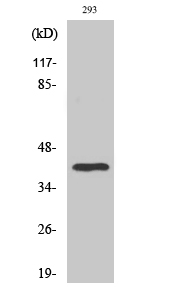TBP Polyclonal Antibody
- Catalog No.:YN5458
- Applications:WB;IHC;IF
- Reactivity:Human;Mouse
- Target:
- TBP
- Fields:
- >>Basal transcription factors;>>Huntington disease;>>Spinocerebellar ataxia;>>Human papillomavirus infection;>>Human T-cell leukemia virus 1 infection;>>Viral carcinogenesis
- Gene Name:
- TBP
- Protein Name:
- TATA-box-binding protein (TATA sequence-binding protein) (TATA-binding factor) (TATA-box factor) (Transcription initiation factor TFIID TBP subunit)
- Human Gene Id:
- 6908
- Human Swiss Prot No:
- P20226
- Mouse Swiss Prot No:
- P29037
- Immunogen:
- Recombinant Protein of TBP
- Specificity:
- The antibody detects endogenous TBP protein
- Formulation:
- Liquid in PBS containing 50% glycerol, 0.5% BSA and 0.02% sodium azide.
- Source:
- Polyclonal, Rabbit,IgG
- Dilution:
- WB 1:500-1:2000 IHC 1:50-1:200. IF 1:50-200
- Purification:
- The antibody was affinity-purified from rabbit antiserum by affinity-chromatography using epitope-specific immunogen.
- Concentration:
- 1 mg/ml
- Storage Stability:
- -15°C to -25°C/1 year(Do not lower than -25°C)
- Other Name:
- TATA-box-binding protein (TATA sequence-binding protein;TATA-binding factor;TATA-box factor;Transcription initiation factor TFIID TBP subunit)
- Observed Band(KD):
- 38kD
- Background:
- Initiation of transcription by RNA polymerase II requires the activities of more than 70 polypeptides. The protein that coordinates these activities is transcription factor IID (TFIID), which binds to the core promoter to position the polymerase properly, serves as the scaffold for assembly of the remainder of the transcription complex, and acts as a channel for regulatory signals. TFIID is composed of the TATA-binding protein (TBP) and a group of evolutionarily conserved proteins known as TBP-associated factors or TAFs. TAFs may participate in basal transcription, serve as coactivators, function in promoter recognition or modify general transcription factors (GTFs) to facilitate complex assembly and transcription initiation. This gene encodes TBP, the TATA-binding protein. A distinctive feature of TBP is a long string of glutamines in the N-terminus. This region of the protein modulates the DNA bin
- Function:
- disease:Defects in TBP are the cause of spinocerebellar ataxia type 17 (SCA17) [MIM:607136]. Spinocerebellar ataxia is a clinically and genetically heterogeneous group of cerebellar disorders. Patients show progressive incoordination of gait and often poor coordination of hands, speech and eye movements, due to degeneration of the cerebellum with variable involvement of the brainstem and spinal cord. SCA17 is an autosomal dominant cerebellar ataxia (ADCA) characterized by widespread cerebral and cerebellar atrophy, dementia and extrapyramidal signs. The molecular defect in SCA17 is the expansion of a CAG repeat in the coding region of TBP. Longer expansions result in earlier onset and more severe clinical manifestations of the disease.,function:General transcription factor that functions at the core of the DNA-binding multiprotein factor TFIID. Binding of TFIID to the TATA box is the ini
- Subcellular Location:
- Nucleus .
- Expression:
- Widely expressed, with levels highest in the testis and ovary.
- June 19-2018
- WESTERN IMMUNOBLOTTING PROTOCOL
- June 19-2018
- IMMUNOHISTOCHEMISTRY-PARAFFIN PROTOCOL
- June 19-2018
- IMMUNOFLUORESCENCE PROTOCOL
- September 08-2020
- FLOW-CYTOMEYRT-PROTOCOL
- May 20-2022
- Cell-Based ELISA│解您多样本WB检测之困扰
- July 13-2018
- CELL-BASED-ELISA-PROTOCOL-FOR-ACETYL-PROTEIN
- July 13-2018
- CELL-BASED-ELISA-PROTOCOL-FOR-PHOSPHO-PROTEIN
- July 13-2018
- Antibody-FAQs



